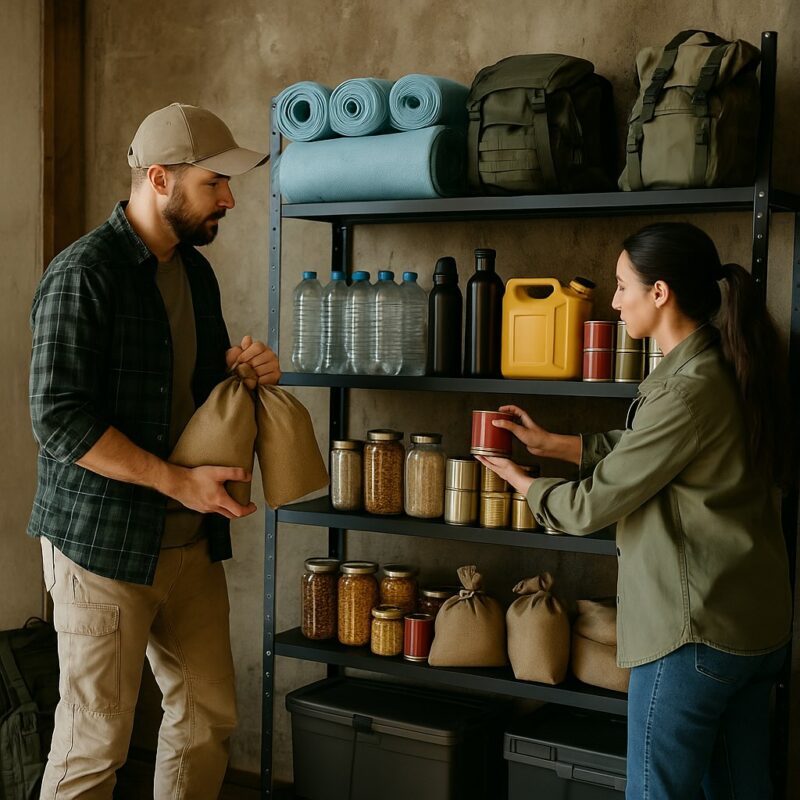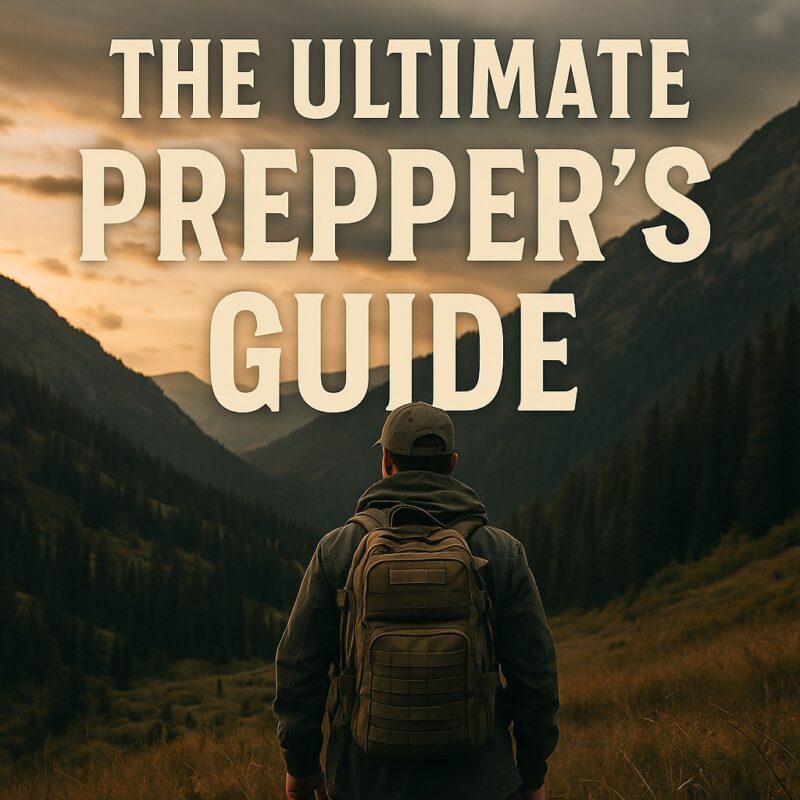Prepper's Corner
The Ultimate Prepper’s Guide: How to Prepare for Anything
Introduction
If the last few years have taught us anything, it’s that stability is an illusion. Natural disasters, pandemics, economic collapses, supply chain breakdowns—they’ve all exposed how fragile modern life really is. This prepper’s guide isn’t about panic. It’s about control. It’s about taking your survival into your own hands, stacking your odds, and ensuring you and your family stay safe no matter what hits.
Whether you’re new to preparedness or already living the lifestyle, this guide will walk you through everything you need—from water and food storage to tactical defense and off-grid survival.
Mindset First: Why Prepping Matters
Before we dive into bug-out bags, solar panels, and ammo storage, you need the right mindset. Prepping is not about fear—it’s about resilience.
- Self-Reliance: You can’t depend on systems that are designed to fail under pressure.
- Adaptability: When things don’t go according to plan, your ability to pivot will save your life.
- Simplicity: Over-complicating your gear or plans leads to confusion when it matters most.
Prepping is a lifestyle, not a weekend hobby. And if you do it right, it doesn’t make you paranoid—it makes you prepared.
Step 1: Building Your Prepper Foundation
Let’s start with the basics. The first step in any prepper’s guide is understanding your risk profile. What are you preparing for?
- Natural disasters (hurricanes, wildfires, floods)
- Power grid failure
- Civil unrest
- Economic collapse
- Supply chain disruption
- Pandemic or biological threat
- EMP or cyberattack
- Long-term off-grid living
Once you’ve identified your top threats, you can prioritize your gear, storage, and skills.
Step 2: The Rule of Threes (Survival Priorities)
Every prepper should understand the Rule of Threes:
- 3 minutes without air
- 3 hours without shelter in extreme conditions
- 3 days without water
- 3 weeks without food
Your preps should reflect that order. First protect your lungs, then your body, then your hydration, and finally, your long-term food supply.
Step 3: Water Storage and Filtration
Water is the foundation of life—and the first thing that disappears in a crisis.
Storage Goals:
- 1 gallon per person per day, minimum
- 3-day emergency supply = 3 gallons per person
- 30-day supply = 30 gallons per person (or a way to collect and purify)
Best Practices:
- Store sealed water containers in cool, dark areas
- Rotate every 6–12 months
- Use stackable 5-gallon jugs, 55-gallon drums, or water bricks
Filtration Essentials:
- Sawyer Mini or Katadyn filter
- Purification tablets (backup)
- Gravity-fed system for home use
- Boiling as a last resort
Pro Tip: Collect rainwater with barrels and add first-flush diverters to reduce contamination.

Step 4: Food Storage That Won’t Fail
Food security means options. Never rely on one type of storage.
Types of Prepper Food Supplies:
- Short-Term Pantry Staples (3–6 months)
- Rice, beans, oats, canned goods, nut butters
- Focus on calorie-dense, shelf-stable items
- Rotate and eat what you store
- Freeze-Dried Meals (2–25 year shelf life)
- Brands like Mountain House or ReadyWise
- Ideal for bug-out bags or quick meals
- Lightweight and easy to store
- Bulk Long-Term Storage (1–5 years+)
- 5-gallon buckets with Mylar bags and oxygen absorbers
- Wheat berries, lentils, powdered milk, sugar, salt
- Label, date, and track everything
- Grow Your Own
- Raised beds, container gardening, hydroponics
- Focus on high-yield, fast-growing crops
- Learn how to save seeds
Food is more than fuel—it’s morale. Include spices, comfort items, and coffee.
Step 5: Security and Defense
Preparedness isn’t just about food and water. If things get bad, you may need to defend yourself or your supplies. Security should be layered, discreet, and adaptable.
Home Defense:
- Reinforced doors and window locks
- Motion-activated lighting
- Security cameras (ideally with off-grid battery backup)
- Alarm systems with silent panic options
Personal Defense:
- Firearms: A reliable rifle, shotgun, and pistol, plus proper training and safe storage
- Non-lethal tools: Pepper spray, tasers, tactical flashlights
- Tactical gear: Plate carriers, hearing protection, eye protection
Training Over Toys:
Gear without skills is a liability. Train regularly in:
- Firearm safety and marksmanship
- Close-quarters defense
- Situational awareness
And always know your local laws.
Step 6: First Aid and Medical Prepping
In a crisis, you are your own EMT. A proper first aid setup goes beyond Band-Aids.
Three Levels of Medical Prepping:
- IFAK (Individual First Aid Kit):
- Tourniquet (CAT or SOF-T style)
- Trauma dressing
- Hemostatic gauze (Celox or QuikClot)
- Chest seal
- Gloves, shears, Sharpie
- Home Medical Kit:
- Antibiotics, antiseptics, OTC meds
- Thermometer, blood pressure cuff
- Suture kit (if trained)
- Dental emergency kit
- Long-Term Medical Planning:
- Backup prescription meds
- Medical reference books (like Where There Is No Doctor)
- Training in CPR, wound care, trauma response
Stockpile not just gear—but knowledge. Survival favors the educated.
Step 7: Bug-Out and Bug-In Planning
Not every crisis means running. Sometimes staying put is smarter. But you should be ready for both.
Bug-In Basics (Shelter in Place):
- Keep blackout curtains, fans, insulation materials
- Stock a 30+ day supply of food, water, meds, and sanitation supplies
- Alternative cooking methods: camp stove, solar oven, rocket stove
- Entertainment: Books, cards, board games—mental health matters
Bug-Out Strategy:
- Know when to go—leave early, not late
- Pack a fully loaded bug-out bag (BOB) for 72 hours
- Have multiple routes and rally points
- Establish a bug-out location (BOL): off-grid cabin, friend’s land, etc.
- Store caches en route if possible (buried or hidden resupply kits)
The best plan is flexible and based on real-world scenarios—not fantasy survival dreams.
Step 8: Power Systems for Grid-Down Scenarios
When the lights go out, your survival gear is only as useful as your ability to power it. Redundant, off-grid power systems are a cornerstone of advanced prepping.
Short-Term Power:
- Power banks and battery packs
- Rechargeable AA/AAA batteries with solar charger
- Hand-crank radios and flashlights
Mid-Term Power:
- Portable solar panels (folding, lightweight)
- Solar generator or solar power station (Goal Zero, Jackery, etc.)
- Inverter connected to a car battery (short-use backup)
Long-Term Power:
- Roof-mounted solar arrays with battery storage
- Wind turbines (if your location allows)
- Backup gas or diesel generator (but store fuel safely and rotate)
Don’t forget:
- Surge protectors for sensitive gear
- EMP protection for key electronics (Faraday bags or cages)
If you rely on electronics—GPS, HAM radios, water pumps—you need a plan to keep them alive when the grid dies.
Step 9: Communication When Everything Goes Silent
In a disaster, comms go down fast. Cell networks are overloaded or cut. The internet? Gone. You need alternate ways to talk and listen.
Emergency Comms Toolkit:
- NOAA crank radio for weather and alerts
- Two-way radios (GMRS/FRS) for local team or family coordination
- HAM radio (amateur radio) for regional and global updates (requires a license)
- Signal mirror and whistle for silent comms
- Dry erase board or waterproof notebook for written instructions
Train your team on basic radio protocols. Know your frequencies. Pre-program devices. Communication is intel—and intel is life.
Step 10: Community and Mutual Assistance
Forget the lone wolf fantasy. Long-term survival hinges on trust, teamwork, and shared resources.
Build Your Tribe:
- Start with family and neighbors
- Identify skills: medical, mechanical, hunting, gardening, security
- Plan together: routes, meetups, fallback points
Community Roles:
- Defender
- Medic
- Engineer/technician
- Farmer/gardener
- Quartermaster (inventory control)
You don’t need to do everything. You need to know someone who can.
Mutual assistance groups (MAGs) and trusted local coalitions can dramatically increase your survivability and reduce burnout.
Step 11: Barter and Off-Grid Economy
If cash loses its value or supply chains freeze, you’re going to be trading for survival. In a post-collapse world, skills and goods are currency.
High-Value Barter Items:
- Ammo (small quantities, never your full stash)
- Batteries and power banks
- Alcohol (drinking, sterilization, barter)
- Cigarettes, coffee, instant noodles (comfort items are king)
- Hygiene items (toilet paper, soap, menstrual products)
- OTC meds (painkillers, allergy meds, antibiotics)
- Lighters, matches, fuel tabs
Rules of Barter:
- Never show all your stockpile
- Don’t trade what you can’t afford to lose
- Use neutral zones or trusted networks
- Security first—never let barter lead someone back to your home base
Barter is part gear, part street smarts. Prep accordingly.
Step 12: Skill Building: Your Most Valuable Asset
Skills are the only preps you can’t lose or run out of. Focus on the ones that make you valuable in any group or scenario.
Must-Have Survival Skills:
- Fire starting and shelter building
- Water purification
- First aid and trauma care
- Food preservation: canning, dehydrating, salting
- Gardening and seed saving
- Home repair and basic construction
- Communications (HAM radio)
- Defensive firearm training
- Navigation without GPS
Rotate training into your life regularly. Don’t just watch YouTube—practice until it’s muscle memory.
Step 13: Critical Documents and Backup Plans
Even in chaos, paperwork matters—especially when things return to order. Keep your essential documents protected and accessible.
What to Store:
- Birth certificates, passports, IDs
- Property deeds and insurance
- Medical records, prescriptions
- Emergency contacts
- Local maps (paper)
- Copies of licenses (HAM, firearm, etc.)
How to Store Them:
- Waterproof/fireproof pouch in your bug-out bag
- Encrypted USB drive or offline backup
- Hidden safe or sealed cache offsite
Also: Write down your bug-out plan, rally points, and radio frequencies in hard copy. Digital plans die fast.
Step 14: Preparing for Full Collapse
Now we’re talking real worst-case scenario—years without grid power, infrastructure, or government aid. This is where preppers separate from survival tourists.
Core Areas to Master:
- Self-sufficient food production: Chickens, rabbits, gardens, permaculture
- Water sourcing & storage: Wells, rain catchment, filtration
- Fuel independence: Wood-burning stoves, solar cookers, biofuels
- Long-term defense: Early warning systems, trained security teams, hardened perimeters
- Community structure: Roles, code of conduct, conflict resolution
This is long-game prepping. You won’t learn it all in a weekend. But each step you take now buys you options later.
Final Thoughts
Prepping isn’t about hoarding or fear. It’s about control in a world that constantly reminds us how little of it we truly have. It’s about choosing resilience over dependency. Action over apathy. Freedom over fragility.
Start with the basics. Stack skills. Build your network. Layer your gear. And above all—don’t wait for the world to shake before you get ready.
The time to prepare was yesterday. The second-best time is right now.
We want to know!
What’s the one prep you’re most proud of? Or the one you know you’re behind on? Drop it in the comments and let’s sharpen each other. This is the Ultimate Prepper’s Guide—and it never stops evolving.


